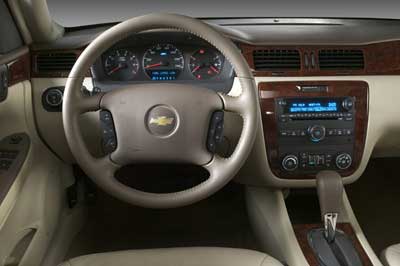Recent Articles
Popular Makes
Body Types
2006 Chevrolet Impala Review
Extreme Makeover: Car Edition
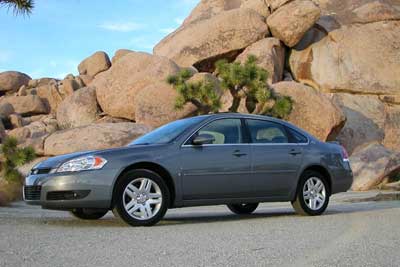
Chevrolet sold more Impalas in 2005 than any other domestic nameplate, making it the third best-selling car in the country after the Honda Accord and Toyota Camry. But, what GM fails to mention is that a gigantic chunk of those Impalas became rental cars, taxi cabs, free rides for traveling salespeople and government flunkies, and undercover cop cars for plain-clothes detectives. Very few consumers like you actually parked one in a suburban driveway, unlike the hundreds of thousands of Accords and Camrys that blanket master-planned communities from Portland, Maine to Portland, Oregon. Those are almost exclusively purchased by people like you, people looking for attractive, dependable, daily transportation for years to come. Impalas are usually bought using corporate or government budgets by bean counters looking for the lowest price. That’s changing for 2006, or at least it should, because Chevrolet took that awful contraption from last year and gave it the equivalent of an Extreme Makeover: Car Edition. Know how buyers of old homes will rip the thing down to the studs and rebuild without bulldozing the entire structure? That’s what Chevy did with the 2006 Impala, instituting a highway beautification program in the process. The rebuilt Impala might share fundamental bits and pieces with the car that’s been haunting Avis and National rental lots since 2000, but this version is so much improved that plastic surgeons in Beverly Hills are green with envy. Well, not really. Impalas seen in Beverly Hills still come from Avis or National. But in the rest of the country, this newly refined ride is selling at a brisk clip, and General Motors is wisely limiting both production and fleet sales in an effort to keep transaction prices high by matching supply with demand for the car. That will translate to better resale values, a perception of greater desirability, and might make us all forget about the ogre born at the start of the 21st century. Chevy offers the 2006 Impala in four flavors: LS, LT, LTZ, and SS. All but the V8-equipped Impala SS get a V6 engine, displacing 3.5 liters and making 211 horsepower in the LS and LT, or 3.9 liters and cranking out 242 horsepower in the LT and LTZ. A four-speed automatic transmission puts the power to the pavement through the front wheels, and the Impala gets a four-wheel independent suspension, four-wheel-disc brakes, power rack-and-pinion steering, and a choice between 16- or 17-inch wheels. Pretty standard stuff, this. Side curtain airbags and OnStar telematics are included on every 2006 Chevrolet Impala, and antilock brakes are optional on Impalas with the 3.5-liter V6 but standard on models with the 3.9-liter V6. Traction control is also available, but don’t look for a stability control system on this family sedan, because there isn’t one. But, the Impala LS does come with air conditioning, power windows, power door locks with keyless entry, power mirrors, cruise control, a tilt steering wheel, an eight-way power driver’s seat, and a CD player. Choose the LT model and you add remote engine starting, dual-zone manual climate control, floor mats, a compass, and an outside temperature display. Upsize your V6 engine to the 3.9-liter mill, and the Impala LT also comes with traction control, ABS, a tire pressure monitor, bucket seats with a center console, a folding rear seat, a leather-wrapped steering wheel with auxiliary controls, illuminated visor mirrors, fog lights, 17-inch alloy wheels, and a rear spoiler. Finally, there’s the top-shelf trim, the LTZ, with all these features plus leather upholstery, heated front seats, heated side mirrors, satellite radio, a Bose audio system, a six-way power front passenger’s seat, and a programmable transmitter. For this test drive, we selected a 2006 Chevrolet Impala LTZ with all the fixin’s. Base price was an extremely reasonable $26,490 including the $660 destination charge, to which a six-disc in-dash CD changer was added for a final sticker of $26,785. Our test car did not have the optional power sunroof, which would have run another $900. We cruised around southern California for a week, averaging 21 mpg, and came away from the drive impressed with what GM has done here. But we still think the price needs to come down even more before the general consumer will consider this Chevy over an equivalent Honda, Nissan, or Toyota.
Driving Impressions
James Fabin’s 2006 Chevrolet Impala Driving Impressions: There was something familiar about the keys I held to the 2006 Chevrolet Impala, a sense that I had done this dozens of times before. But this time, one thing was different: I wasn’t standing in a rental car lot. And because I knew the Impala picked up a number of major improvements for 2006, I was excited to see how far this car had progressed. Really, I wanted to see. I’m not being sarcastic. Adjusting the Impala’s seat, mirrors, and steering wheel to my likings was easy – the controls seemed to magically appear just where I expected them to be. At first the new Impala appeared to be missing buttons – the large dash was just too clean and tidy. But all the radio controls were present, with the climate controls stashed just below those – nothing missing here. However, taking to the road was not as delightful. While Chevrolet’s minimalist approach to interior design is nice, it went a little too far with the “delete” option by removing the gear markings from the automatic shifter surround. The large shifter clunked limply through each of its options with a fairly heavy rowing action, and the only indication of what gear was selected was on the dash below the speedometer. Under normal driving conditions on a straight road, the Impala soaked up bumps while providing a smooth ride that wouldn’t be out of place for a luxury car. It felt solid and actually drove like a smaller vehicle, in part due to its small turning radius. The mirrors seemed somewhat small at first, but somehow they nearly eliminated every blind spot from around the vehicle. Parking the Impala was easy thanks the great visibility, and if it wasn’t for the oversized steering wheel constantly reminding you this is a large car, you’d swear this vehicle was two feet shorter than it is. On the highway, the Impala’s 3.9-liter V6 engine felt powerful and sounded refined. The transmission was quick to downshift to help overcome slower vehicles, but upshifts were on the harsh side. With speed comes wind and the Impala allows an excessive amount of roar into the cabin – so much so that I repeatedly checked to make sure all the windows were closed and even pulled over at one point to ensure all the doors were shut tight. In addition to wind noise, too much excess highway racket is allowed into the cabin. More aggressive drivers will find the Impala’s suspension to be too soft. Push the car into a corner and the suspension responds with excessive body lean, the tires barking in protest. The Impala has a natural tendency to understeer at the limit and providing more throttle input only provokes the vehicle to protest louder. Emergency maneuvers are not the Impala’s strength either – attempting to swerve and miss an obstacle at 40 mph will have you fighting the Impala’s suspension to maintain control. One thing any driver will like about the Impala is the brakes, which respond quickly with heavily boosted, speed erasing power. Thom Blackett’s 2006 Chevrolet Impala Driving Impressions: There’s no disputing that domestic car makers have seen their share of criticism over the past several years, 99 percent of it deserved. However, in retrospect one can think of it as tough love, since it was those harsh words and demand for improvement that led to cars like the 2006 Chevrolet Impala. With a recent price reduction that put our LTZ model in the mid $26,000 range, the Impala even offers a dose of value. The standard-issue 240-horsepower V6 offers plenty of power for this large sedan, and the smooth-shifting yet outdated four-speed automatic transmission is nearly seamless in its operation, even when the throttle is matted for power. Torque-steer is nearly nonexistent, but there’s a bit of squat and dive resulting from hard starts and stops. Quick highway passes are a breeze, pulling away from red light racers is doable, and you can even catch a little rubber from the inside front tire on hard turns. My main complaint with the Impala LTZ’s powertrain, aside from engine noise that can be a bit much at full revs, has to do with the touchy gas pedal – in slow starts or while cruising at a good clip, all is fine, but sudden starts and accelerating from a slow roll can bring on a snappy response that’s hard to regulate. That quibble carries over to the brakes, as well, though there’s little else to complain about, except for an ABS system that is a little quick to react. Otherwise, the four-wheel disc setup does a terrific job of bringing this Chevy to a quick and secure stop. The 2006 Impala LTZ is equally adept at handling, offering an acceptable amount of body roll for a large sedan, absorbing bumps with little impact on the somewhat vague steering system, though understeer rears its ugly head when this front-driver gets pushed hard into a corner. Buyers looking for a true sport sedan won’t be satisfied with the 2006 Chevrolet Impala, plain and simple. But for those who seek an affordable ride that blends decent power with acceptable handling into a spacious package, Chevy has something worth consideration. Christian Wardlaw’s 2006 Chevrolet Impala Driving Impressions: Call this an American Toyota Camry with just a few faults that keep it from being 100-percent competitive. It offers decent acceleration, though this 3.9-liter V6 sure doesn’t feel like it’s putting 240 horsepower to the front wheels. It lacks some mid-range grunt for passing, and the transmission takes a moment to downshift for added power. Also, I caught the transmission napping from time to time when cruising around town. Still, this four-speed unit shifts well and smoothly most of the time. Handling lands in the adequate category, too. The Impala’s nose, like many front-drive sedans, is quick to understeer in tighter turns. The slow, numb steering does its part to discourage rapid transit, and it’s nice that the tires don’t squeal much when under duress. Where the Impala shines is in its braking and ride quality. The brakes are responsive, with good pedal feel and easy modulation, proving effective for quick stops. The suspension filters all but the sharpest impacts from the interior, providing a good blend of road feel and smoothness. In fact, I think it’s better than the rather stiff Honda Accord. The 2006 Chevrolet Impala is not fun to drive – the closest you can get to good times is with the V8-powered SS version – but neither is it a chore.
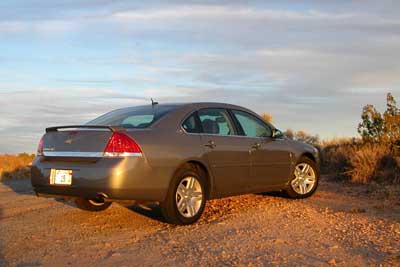
Comfort
James Fabin’s Opinion of the 2006 Chevrolet Impala’s Comfort: When it comes to interior comfort and support, the 2006 Chevrolet Impala falls short in many areas. The seats are large and flat, with not an ounce of side bolstering. After just 20 minutes behind the wheel, I found myself wanting to adjust the seat again to get more comfortable. Rear passengers are also treated to large flat seats, and while there is a good amount of legroom, tall rear passengers will have their knees pressed into the front seatbacks. Another area where the Impala falls short is with the climate control. While the heater quickly roasted the entire cabin, the air conditioning worked hard to provide cool air (that’s “cool” not “cold”). Even on its coldest setting, using re-circulated air, the Impala was never able to make the cabin cold as I drove it on a warmish mid-70s California winter day. Thom Blackett’s Opinion of the 2006 Chevrolet Impala’s Comfort: They say that the only things guaranteed in life are death and taxes. I’d like to add large sedans that are comfortable, because if there’s one common trait to these cruisers, it’s usually their ability to softly cradle driver and passengers. The 2006 Chevrolet Impala LTZ falls right onto the fringe here, with wide front buckets that are light on effective bolstering but easy to get in and out of, and an expansive rear split folding bench seat. Front cushioning is a bit stiffer than the rear, but both have padded center armrests (fold-down in the rear) and rubberized door sills and armrests. Two-setting butt warmers are standard on the LTZ for the driver and front passenger, while all outboard passengers are afforded plenty of foot, leg, and head room; the rear center seat rides high and firm. There’s a tilt steering wheel with multiple settings, but that barely offsets the driver’s manual lumbar lever that requires some serious muscle to fully crank up. Assuming that there’s a good percentage of older folks in the Impala’s demographic, I see some Medicare claims coming down the pipeline. And passengers of any age might appreciate adjustable rear headrests, which are absent here. Christian Wardlaw’s Opinion of the 2006 Chevrolet Impala’s Comfort: Don’t expect the 2006 Chevrolet Impala to be a quiet car; our tester suffered lots of wind noise, a fair amount of road rumble, and a rattling dashboard. And though it’s marketed by Chevrolet and rated by the EPA as a full-size car, the 2006 Impala is really a mid-size sedan. In fact, if passenger space is important to you and you want to buy a Chevy, I recommend considering the less expensive Malibu, which is just as comfortable up front with more useable space in back. The Impala’s back seat is tight for tall adults if people of similar height are occupying the front seats. My legs were flush against the front seatbacks and my toes were stuffed under the seat while I sat on a rather low bottom cushion. Getting in and out of the back seat is made difficult due to tight footwells, small door openings, and low cushion. Overall, for a car designed to carry five or six adults, this rear seat comfort problem is unacceptable. Comfort levels are much better up front. The power adjustable driver’s seat is supportive, entry and exit are easy, the leather-wrapped steering wheel is nice to hold, and both the upper door panels and center armrest are softly padded. The only downside was that my left knee rested against the hard plastic seam under the pod containing the power window, power door lock, and power mirror controls. This was especially painful when bracing that leg against the door for right-hand turns.
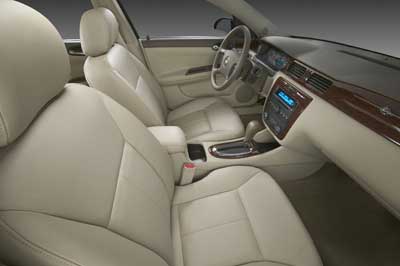
Quality
James Fabin’s Opinion of the 2006 Chevrolet Impala’s Quality: Chevrolet did some things very well in the quality department, but some areas still need more attention. The 2006 Impala’s dash buttons and controls all worked well and had a nice tactile feel – some of the buttons and controls felt like they came from a European luxury car. There was only one control that stood out as odd and had me question whether it was broken – the air flow selection switch. The selector knob turned with the same tactile feeling as the others, but stopped in between the unevenly spaced selections. It also had a very small, nearly invisible green LED imbedded in a chrome ring to indicate which item was selected. With so much done right, I am confused as to how this one knob was allowed through the system with its obvious flaws. Overall build quality isn’t up to Honda, Nissan, or Toyota standards, but Chevrolet is making progress at catching up. The Impala’s interior is no longer a puzzle of random cheesy hard plastic pieces – it is now clean and has an overall quality feel to it. Many of the plastics used inside the Impala look and feel great, with the exception of the large hard plastic dash, which is so hard and hollow sounding that it appears out of place. Fit and finish inside and outside the cabin was good, with panels and body lines aligned properly on the exterior and even gaps all around the car. However, Chevrolet still needs to focus on reducing squeaks and rattles – our vehicle had two rattles in the dash, one on each side. Thom Blackett’s Opinion of the 2006 Chevrolet Impala’s Quality: There’s a reason GM has seen market share tank over the years, and it’s not because shoppers can’t find the thousands of dealers in nearly every town across the nation. The main culprit has been quality, something clearly addressed by the 2006 Chevrolet Impala’s designers. A walk around our LTZ test car demonstrated a new focus on tighter and consistent gap tolerances, with headlights and taillights fitting flush and properly aligned hood and trunk panels. This may seem like basic Car Building 101 stuff, but these points have been largely absent on Chevy models of the past, and the loose grille insert indicates there’s still some work to be done. Inside, the quality is up, though not to the same degree as the exterior. While good overall, I noticed some loose plastic on the rocker panels and A-pillars, faux wood dash trim that wasn’t completely secure, and flimsy plastic used to construct the lower center console and power seat control panels. Get really picky and you’ll notice that the vertical side pieces of the dash don’t fit 100 percent with the contoured dash cap, and the plastic wood and chrome shift plate has too much flex. In time, these issues may add to the few rattles already emanating from the Impala’s interior. Christian Wardlaw’s Opinion of the 2006 Chevrolet Impala’s Quality: Though tremendously improved over the old Impala, there’s still evidence of an old-fashioned Detroit cost-cutting mentality when it comes to the new Impala’s quality. The top of the dashboard, the part nobody ever touches, is constructed of a nice soft-touch material that matches the stuff covering the upper door panels. Overhead, a lovely woven mesh headliner with matching plastic pillar trim says “Audi” more than it does “Chevy.” Even the plastic surrounding the stereo and climate controls is upscale. But that’s where the accolades end. The lower part of the dashboard, the part people actually touch and bump legs into from time to time, is hard, thin, glossy plastic. The leather in our Impala LTZ test car felt cheap, the seat upholstery grain didn’t match, and the plastic door panel control bezels were low rent. Likewise, the build quality, though closing the gap with the imports, still displayed evidence of the UAW’s “minimum effort, maximum benefits” work ethic. Inside, our Impala’s dash top was loose, there were inconsistent gaps between steering column and the gauge surround, the glove box door was obviously misaligned, the bezel surrounding the center stack didn’t fit tightly, and the driver airbag cover assembly was off. Outside, the front fascia didn’t fit well, the center and right-side grille inserts were loose, the rear fascia fit poorly at the wheel wells, and the taillights fit inconsistently with the trunk. Though Chevrolet has improved the Impala’s overall fit and finish, effort and expenditure levels need to be bumped before traditional import buyers might be swayed. As it stands, the new Impala’s quality only thrills previous Impala owners. Honestly, the fleet buyer at Avis or the local school district could care less, and die-hard Chevy fans would buy a new Impala anyway. Chevy needs to court those who might buy a Honda or Toyota, and this car still isn’t up to snuff.
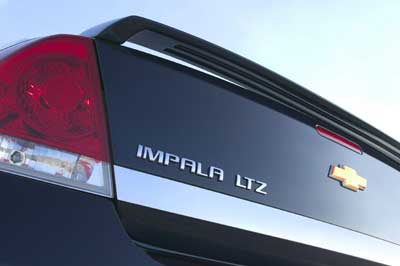
Design
James Fabin’s Opinion of the 2006 Chevrolet Impala’s Design: Chevrolet has done a good job of updating the 2006 Chevy Impala’s design to make it more modern looking, while still not screaming “look at me.” The front end is more tapered and has more character then the previous Impala, which was pretty boring. The Impala also has a nice arching body line above the rear wheels that gives it a bit of sporty flair while tying it to classic Chevrolets of the past. It also gives the Impala a subtle look of motion from the front doors back, as if the car is ready to launch forward at any moment. At the rear, the Impala features dual exhaust outlets but their small size appears more economical then sporty. Getting in and out of the Impala is fairly simple thanks to the large door openings and plenty of head room, but rear passengers will have to watch their footing due to a small lower opening. The doors open with a light feeling, but close quickly with a very heavy hammer action. Chevrolet over-designed the door hinges, so be careful with small fingers in the back seats when closing the doors. Thom Blackett’s Opinion of the 2006 Chevrolet Impala’s Design: Sometimes bland works just fine. Personally, I’d rather start with a blank slate and add some flavor rather than being stuck with some funky style that can’t be diluted. Such is the case with the redesigned Chevrolet Impala. For 2006, a sleek new front end with shiny headlights, gentle body side creases, and a clean tail end – all with body-color or chrome panels in the right places – give the Impala an attractive look, though upon seeing this ride close up, one company staffer wondered why anyone would consider such a boring car. To each his own, so they say. Our LTZ tester was dressed up with stylish alloy wheels, a subtle but noticeable rear spoiler, and lower fog lights up front. No, it’s not exactly the final result of an episode of , but it won’t get the local fuzz wondering how you could afford those dazzling spinners, either. The 2006 Impala’s interior is simple, with a gently-curved padded dash cap, simple and straight-forward climate and radio controls, and the latter supplemented with buttons on the steering wheel. Now if Chevy would only spend a few more pennies and replace that awful faux wood trim with something a little bit more upscale. Christian Wardlaw’s Opinion of the 2006 Chevrolet Impala’s Design: Inside and out, the 2006 Chevrolet Impala is attractive and inoffensive – it’s not attention grabbing, but neither are its primary competitors. Our Impala LTZ came with great looking wheels, nice dual exhaust outlets, a BMW rip-off kink at the C-pillar, and contemporary triangular taillights. Chevy has done a great job with the Impala’s huge trunk, too. Liftover height is thigh high, and features a large opening. The lid is supported by gas struts rather than cheaper gooseneck hinges, there’s a handy cargo net, and the rear seats flop right down to expand space. There’s also a slick cargo solution inside the Impala, one I don’t recall seeing in any other family sedan on the market. Flip the rear bottom cushion up, and you expose a storage area under the back seat that allows the Impala to carry taller items upright – things like houseplants that cannot be placed horizontally in the trunk. The bottom of the seat cushion also has hooks for holding plastic grocery bags. See, you really need an SUV. Inside the 2006 Impala, simplicity rules with a hint of retro in the dual-cowl dash design. Our test car was decorated in a dark charcoal color that would have been downright depressing if not for the light gray headliner and pillar covers. Perhaps Impalas with this interior color should get a brushed aluminum accent trim rather than the dark fake wood currently provided. For an American car, the Impala’s front cupholder design is not good because it’s too small for two big drinks. Storage areas are plentiful, and there’s even a pocket on the leading edge of the driver’s seat, like in a Saab. Control layout is a mixed bag. There’s no PRNDL display on the center console, so the driver must look at the gauge cluster to ensure proper gear selection. The stereo’s tuning knob is a stretch to reach for the driver, the stereo pre-set buttons are too small, I dislike having the wipers integrated on the turn signal stalk, and the Impala lacks automatic up/down for the power windows (the driver’s window is auto-down only). Plus, the power adjustable side mirrors on our test car were not responsive to inputs. One thing I really liked about the Impala’s controls is the move toward knobs with integrated buttons. For example, the headlight control is a knob with a button inside for the fog lights. A similar design is used for the stereo’s volume/power and tune/audio functions, and the climate system’s air flow/defogger and fan speed/AC systems. The result is a simple and elegant way to group features and reduce clutter.
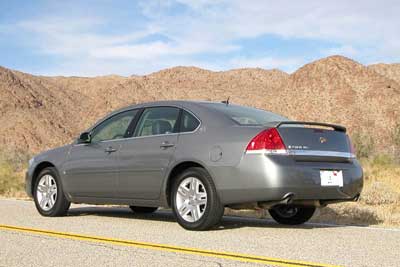
Advice
James Fabin’s Advice about the 2006 Chevrolet Impala: The 2006 Chevrolet Impala has some tough competition. Compared to the Honda Accord and Toyota Camry, the Impala provides more room but with lower quality and less overall comfort. The Dodge Charger is also a worthy competitor, offering better road manners and sharing some of its engineering with Mercedes-Benz. The Nissan Maxima can be had, though stripped of most of its options, for about the same price as the Impala LTZ that we drove. And then there are the Koreans – the Hyundai Azera offers more standard features and a longer warranty. Looking at price alone, it may appear the Impala offers the best value – but that lower price was made by cutting corners, corners that are too visible as you drive the car. My advice is to take your time and test drive the competitors before making your purchase – you may find something else a bit more rewarding to live with. Thom Blackett’s Advice about the 2006 Chevrolet Impala: Around these parts, there’s obviously lots of talk about which cars are winners and losers, which offer the most bang for the buck, which look and perform the best, and which we’d recommend. For quite some time, with notable exceptions, when it comes to our recommendations, discussion has been limited to Hondas, Toyotas, Nissans, Chevrolet Corvettes, Chrysler 300s, and so on, because it’s got to be something we’d put in our own driveways and make payments on every month. Given that, I’d have no problem suggesting a test drive of the 2006 Chevrolet Impala. Of course, that’s after waiting a year or so for Chevy to work out any redesign-year bugs, and since Chevy has a reputation to build and not protect, I’d point out the beatable three-year/36,000-mile warranty to the dealer and start negotiations with invoice as a starting point and work down from there. Christian Wardlaw’s Advice about the 2006 Chevrolet Impala: After cruising around southern California, including a road trip to Joshua Tree National Park, for a week in our 2006 Chevy Impala LTZ test car, I feel like a tourist – and not just because of the surroundings. Scrub the leather interior, and this Impala is just like countless rentals I’ve driven in my past. I’m convinced this impression is related to my olfactory and aural senses, a remembrance of General Motors new car smell combined with the sound of a merely adequate V6 from behind the firewall and a rental agreement tucked above the right visor. Certainly, this impression isn’t due to visual or tactile receptors, since I think the Impala is a nice looking sedan that feels good to drive and proves comfortable over time. As for a recommendation, well, I can’t say I would put this car at the top half of someone’s must-drive list, but if you’re seriously considering the purchase of a Chevy Impala, neither would I steer you clear of the car. And that’s a big improvement over the Impala it replaces.
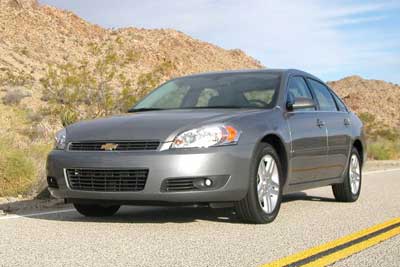
Specifications
Test Vehicle: 2006 Chevrolet Impala LTZ Price of Test Vehicle: $26,785 (including the $660 destination charge) Engine Size and Type: 3.9-liter V6 Engine Horsepower: 242 at 6,000 rpm Engine Torque: 242 at 4,400 rpm Transmission: Four-speed automatic Curb weight, lbs.: 3,650 (estimated) EPA Fuel Economy (city/highway): 19/27 mpg Observed Fuel Economy: 21 mpg Length: 200.4 inches Width: 72.9 inches Wheelbase: 110.5 inches Height: 58.7 inches Leg room (front/rear): 42.3/37.6 inches Head room (front/rear): 39.4/37.8 inches Max. Seating Capacity: Five Max. Cargo Volume: 18.6 cu.-ft. Competitors: Buick LaCrosse, Buick Lucerne, Chevrolet Malibu, Chrysler 300, Dodge Charger, Ford Five Hundred, Ford Fusion, Honda Accord, Hyundai Azera, Hyundai Sonata, Kia Amanti, Mazda 6, Mercury Milan, Mercury Montego, Mitsubishi Galant, Nissan Altima, Nissan Maxima, Pontiac G6, Pontiac Grand Prix, Subaru Legacy, Suzuki Verona, Toyota Avalon, Toyota Camry, Volkswagen Passat
Photos by Christian J. Wardlaw and courtesy of General Motors
